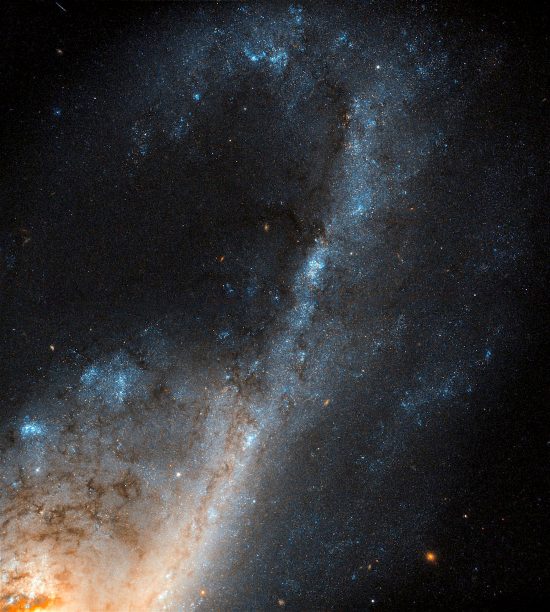Apr 14, 2017
Stars form at a faster rate in a starburst galaxy.
Astronomers using the Hubble’s Wide Field Camera 3 (WFC3) recently announced that a distant galaxy is creating stars at an anomalous rate. So-called “starburst galaxies” contain regions where stars form at “a breakneck rate”, so fast that they consume their gas and dust faster than it can be replaced.
NGC 4536 is a gas-rich galaxy. Young stars shine brightly in high-frequency infrared and low frequency radio waves. Conventional theories suggest that stars emit light in the ultraviolet range once they ignite: they disgorge vast quantities of dust from their nebular cloud nursery. Astronomers believe that hot stars are young stars and that radiant energy from their fast-paced consumption of nuclear fuel heats up the surrounding nebular cloud, causing it to glow like an ember in the distance.
An analysis of the galaxy’s redshift places it at 50 million light-years, so its brightness implies a significant population of young stars. New images show several hundred star clusters representing the formation of up to a million stars in a process that is stated to take less than 100,000 years. Along with hundreds of clusters, individual highly luminous stars can be seen.
Distance calculations and the ages of objects are based on the idea that galaxies and stars coalesce out of diffuse clouds of dust and gas under the influence of gravitational attraction. Nebular material begins to undergo thermonuclear fusion and start the process that leads to a new star (or a new collection of stars). The interpretation makes sense if gravity, density and thermal shock are considered without considering Electric Universe theories.
Rather than each new remote observation being identified with “extraordinary properties” or “baffling results” or “mysterious events”, it would make more sense to add the electrical properties of matter in its plasma state to the theoretical formulation and sew up loose ends.
Electrical energy is orders of magnitude more powerful than gravity. “Plasma ropes” that comprise Birkeland currents attract one another over distances in a linear relationship rather than through the “square-of-the-distance” proportions of gravity. That makes Birkeland currents the most powerful long-range attractors (and also short-range repulsors) in the Universe. Electric currents flowing through dusty plasma beget and sustain the stars and the galaxies.
The divergence between the Electric Universe model and the standard model is based on plasma, which comprises 99% of the Universe. Plasma tends to obey the laws of electromagnetism, so gravity and kinetics are subsidiary. The celestial bodies and their interactions are to be understood principally in terms of electrical circuits.
Stephen Smith













